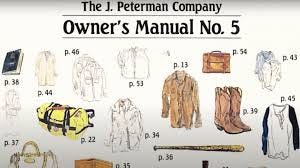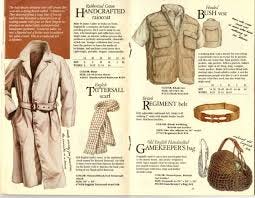Zachary Weiss | April 10, 2024
The J. Peterman Edition
On cinematic universes, Seinfeld, and physical catalogs.
Zachary Weiss is a Manhattan-based brand consultant and writer, focusing on menswear, food, and travel. Follow along with him on Instagram: @ZacharyWeiss.
Zachary here. Skinny, glossy, and usually covered with a water color of some sort of women’s frock, there’s no mistaking the J. Peterman catalog when it shows up in the mail. Approaching the holidays, deliveries seem to pick up in frequency, arriving on what soon starts to feel like a weekly basis. Inside, there’s not a single model’s face, or even a photograph of a product — only watercolor illustrations.
These illustrations are accompanied by verbose descriptions of the fictional, international characters that make up the J. Peterman cinematic universe. In the most recent catalog, my personal favorite piece of copy can be found alongside a collection of Italian-inspired linen suiting: “Italian Intelligence. He’s burned in Lisbon. Stockholm feels risky. A man with his skills needs a place to cool his heels. For that, there’s Varenna. He can think here, away from the crush of tourists across the lake in Bellagio. His handler calls him at noon. Dubrovnik is a go. But there’s that feeling in his gut (it hasn’t failed him yet) telling him to stay right here where the air is heavy with the scent of star jasmine, the owner is discreet, and the Viognier is crisp and cold. Matter of fact, he may stay for good.”
The suiting may appear to be aimed at the masses, but the brand’s full offering is nothing short of esoteric. There are Western wool vests. There are tulip-shaped fascinators. There are even several variations of men’s caftans, as well as one (now-discontinued) black tie kimono jacket no one asked for, that I once found at a vintage fair and have worn exactly twice in my life. My own affinity for the brand, however, didn’t truly take hold until April 2020, when I found myself with the common COVID-era combination of endless hours at my disposal to comb through all corners of the e-commerce landscape, coupled with visions of grand travels and celebrations. When J. Peterman found me, I was ready.
Why is this interesting?
Altogether, the core tenets of the company — a print catalog-reliant business selling a wide offering of incredibly niche SKUs at generally-reasonable prices — go against everything a modern omni-channel brand is supposed to be, and yet it endures. With its layers of irony and idiosyncrasy, J. Peterman flies in the face of watered down, pared-back brands selling you the “perfect" crewneck sweatshirt in 12 solid pastel colors. Every time I open the J. Peterman catalog, on the other hand, I’m left equal parts enchanted and confused. With that, I felt it was high time for a dive into the company’s formula.
Our journey begins, like all things do, on Instagram, where the brand touts a small but mighty 12,100 followers. The tagged photos don’t paint a clear picture of who the typical J.Peterman shopper might be, if one even exists, but it’s clear that most of their customers enjoy dressing up in ensembles that are just-shy of character acting. Where a designer like Ralph Lauren may borrow from a tight selection of inspiration points season after season, J. Peterman is less stringent, borrowing from a hearty buffet of eras and geographies. There’s western wear, English boarding school uniforms, embroidered Moroccan finery, a flapper girl, and always, always a tuxedoed spy. Scrolling through those tagged photos, it becomes clear that if J.Peterman customers are united by anything, it’s their bold approach to dressing.
What you won’t find in their Instagram followers, or in who the account is following, is anyone with the surname Peterman. That said, a Peterman family does exist, including Mr. John Peterman, the brand’s namesake, who was profiled in 1997 by the New York Times. The real Peterman is less a capital-F Fashion gadfly, and more of a serial entrepreneur with a taste for the finer things, who saw opportunity in a long cowboy duster coat purchased on a trip to Wyoming in 1986. Almost 40 years later, the coat remains one of the brand’s steadfast core offerings.
Founded in 1987 in Lexington, Kentucky, it was that over the top catalog copy that first sold the duster jacket when it appeared in a mail-order advertisement in The New Yorker. Over the next decade, more products were added, and the company gained traction among the trad set before its fanciful tales became the impetus for Seinfeld’s writers to dream up a fictional character of their own, inspired by the tales they’d read in their J. Peterman catalogs.
Portrayed by John O’Hurly on the hit sitcom from 1995 to 1998, Jacopo Peterman often waxed poetic on past lovers, travels, meals and merriment. "I know what you're going through,” he tells Elaine,, after she has tested positive for opium. "I, too, once fell under the spell of opium. It was 1979. I was traveling the Yangtze in search of a Mongolian horsehair vest.”
Somehow, it was around this point that the brand reached its would-be heyday, with notable shoppers including Oprah, Paul Newman, Frank Sinatra, and Bruce Willis. The company reached $75 million in sales, with most orders placed by phone to a call center manned by 300 staff members. With this growth came larger catalogs and an overzealous attempt at a rapid, costly retail expansion that ultimately led to the bankruptcy of J.Peterman in 1999. Following a tangled two-year web of searching for new funding, the brand emerged with Seinfeld firmly in its rear view. “Seinfeld is kind of a nonstarter for me,’’ John Peterman told Retail Dive in 2018. "'Too many people think we’re a made-up company.’” Such is the bizarre predicament that has chased this brand since the late 90s. Everyone might know your name, but they don’t know that you’re real.
Sweetly, the strongest link the brand maintains with the show is that John O’Hurly, who portrayed Jacopo Peterman (the fictional person who founded the fictional brand) now sits on the board of the directors for J.Peterman (the real brand), and is sometimes known to have lunch with John Peterman (the real person who founded the real brand). This is all hilariously described in this deeper inquiry by Retail Dive.
Headquartered today in Blue Ash, Ohio, J. Peterman now rests under the stewardship of the man himself, with millions of catalogs still going out to the masses, though the looming concern is that these masses continue to age. The bulk of the catalog’s recipients are over 50-years-old. So, while it’s comforting to imagine a world where J.Peterman always exists as a trad deep cut, it’s going to require a rallying of Gen Zs — and their fetish for old money dressing — to don their very own duster coats and take the reins. (ZW)
—
Thanks for reading,
Noah (NRB) & Colin (CJN)
—
Why is this interesting? is a daily email from Noah Brier & Colin Nagy (and friends!) about interesting things. If you’ve enjoyed this edition, please consider forwarding it to a friend. If you’re reading it for the first time, consider subscribing.

